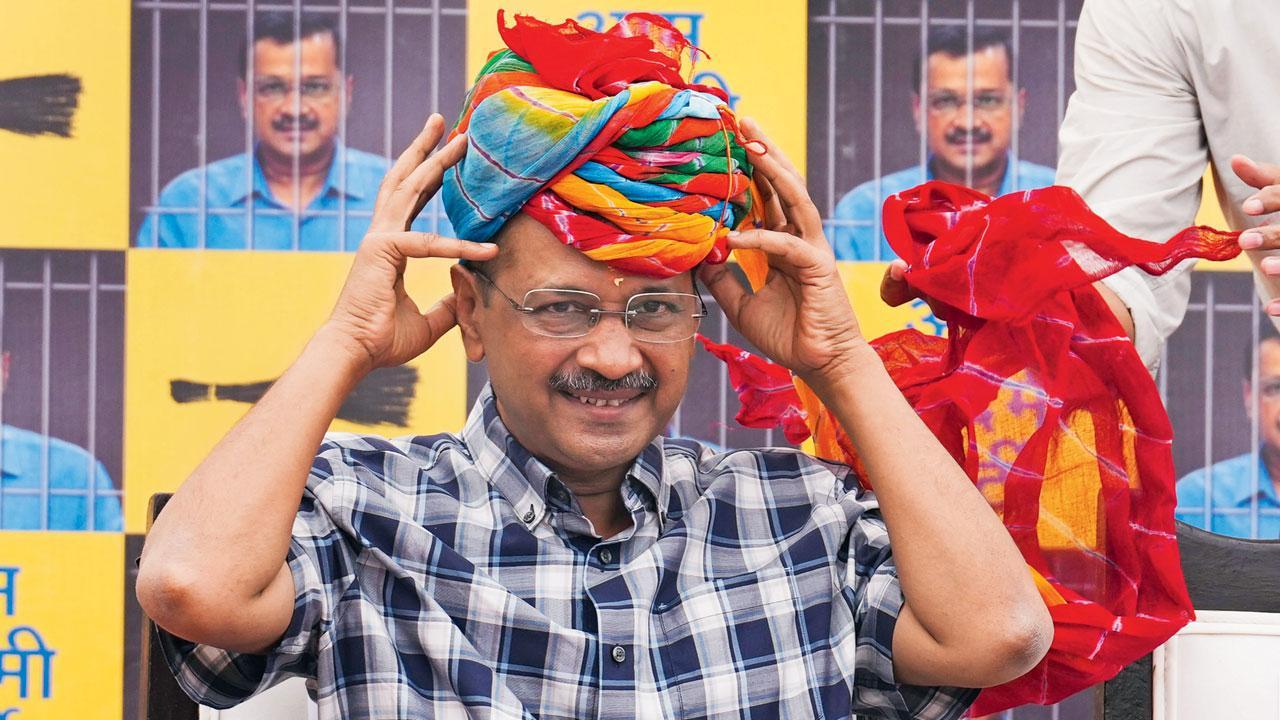The Delhi CM remains the quintessential outsider despite playing by the insider’s electoral rulebook. Possessing a keen understanding of the power of symbolism, he is now a metaphor for injustice

Delhi Chief Minister Arvind Kejriwal at the Aam Aadmi Party office in New Delhi, on May 11, a day after receiving interim bail from the Supreme Court. Pic/PTI
 When Arvind Kejriwal’s Aam Aadmi Party swept, in 2015, the Delhi Assembly elections, winning all but three of 70 seats, political psychologist Ashis Nandy, in an interview, said the greatest challenge before the emerging leader was to retain his appeal as an outsider, generally defined as one who isn’t reared in the political system. Nandy said: “When you come in as an outsider and then try to become an insider, you sacrifice your appeal right there. The Mufflerman should remain like Spider-Man, an outsider. I am not saying he should be a complete outsider because that is suicidal. But he should have one foot outside.”
When Arvind Kejriwal’s Aam Aadmi Party swept, in 2015, the Delhi Assembly elections, winning all but three of 70 seats, political psychologist Ashis Nandy, in an interview, said the greatest challenge before the emerging leader was to retain his appeal as an outsider, generally defined as one who isn’t reared in the political system. Nandy said: “When you come in as an outsider and then try to become an insider, you sacrifice your appeal right there. The Mufflerman should remain like Spider-Man, an outsider. I am not saying he should be a complete outsider because that is suicidal. But he should have one foot outside.”
ADVERTISEMENT
Rarely does a person with a civil society background float a political party. But this is exactly what Kejriwal did, constituting the AAP in November 2012 to fight the 2013 Delhi Assembly elections. He campaigned from his rickety Wagon R, which would grumble every time it went up Delhi’s flyovers. He won 28 seats, and formed the government with the outside support of the Congress, against which it had campaigned furiously.
As chief minister, he remained the quintessential outsider, even sitting on dharna against the Delhi Police. He took the decision of supplying electricity and water to Delhi’s residents at extraordinarily cheap rates. He dared to file an FIR against the Ambanis. And then, 49 days later, he quit as chief minister, to the dismay of Delhiites.
He, then, pitched himself against Narendra Modi, then the Bharatiya Janata Party’s prime ministerial candidate, foraying into Gujarat and firing salvos against him. It required chutzpah to contest against Modi in Varanasi; Kejriwal just about managed to save his deposit. Six months later, he crisscrossed Delhi, apologising for resigning from the post of chief minister. Few insiders would do that. Kejriwal swept Delhi in 2015.
The political class now perceived Kejriwal as an upstart, a nuisance, a threat. Cases after cases were filed against AAP MLAs. The Lt. Governor, a Union government appointee, sought to abort just about every policy of Kejriwal. Yet he revamped government schools and boosted health infrastructure. That power had not killed the outsider in him became evident as he went on a sit-in, in 2018, in Lt Governor’s office, sleeping there for nine nights. And yes, he kept railing against Modi, who demonstrated his popularity by leading the BJP to sweep the 2019 General Election, including winning all of Delhi’s seven Lok Sabha seats.
Yet Delhiites voted Kejriwal back to power, in 2020. It was after this that his transformation began. He stopped firing volleys against Modi, convinced that it had little electoral purchase. Yet, after failing to buy respite from the Centre’s constant nettling, he reverted to finding faults with the prime minister, even mocking him at times. More significantly, Kejriwal effected an ideological shift, adopted Lord Hanuman as the party’s mascot to prove he was a good Hindu, voted for the reading down of Article 370, and stopped speaking for Muslims, although he did not demonise them either. These changes suggested that he had decided to play by the insider’s electoral rulebook.
And then, two years ago, Kejriwal’s persona of the outsider developed cracks as the miasma emanating from the alleged corruption in the Delhi liquor policy enveloped him. Granted that the Enforcement Directorate (ED) has not traced the trail of slush money to any of the accused in the liquor scam, as the Supreme Court pointed out; yet, the accusation spawned the suspicion that there might be some substance to the charge against Kejriwal and others, as it seemed inconceivable to many that the entire liquor scam case could just be a figment of the ED’s imagination.
The insider’s defining attribute is corruption. By this yardstick, Kejriwal was suspected to have become the insider. But then, suddenly, another narrative was birthed on March 21, the day the ED arrested Kejriwal, with the consent, obviously, of the Centre. For citizens, given the power differential between Kejriwal and Modi, the incarceration seemed an instance of Goliath bringing his full might to bear down upon David, to knock him out of the 2024 election campaign.
Kejriwal’s arrest became, overnight, an example of the BJP’s too-muchness. It was considered unfair because an enormously superior power was seen to have deployed an unwarranted method to snuff out opposition, instead of swatting away Kejriwal, the nuisance, through democratic competition.
After March 21, Kejriwal became a metaphor for injustice.
Few can match Kejriwal in waging the battle of symbolism. Contrary to legal advice and common sense, he refused to resign following his arrest, becoming the first chief minister in history to govern, even though notionally, from behind bars. He issued sentimental letters to Delhiites through his wife, expressing concern for their wellbeing. Delhi ministers issued statements spelling out the orders Kejriwal gave them in their jail meetings.
Out of jail on interim bail now, Kejriwal, the metaphor, will likely crisscross the country, personifying, in flesh and blood, the very idea of injustice. His physical appearance—diminutive, diabetic and coughing—will make the metaphor persuasive, as it had been also the case with the outsider tag. The Mufflerman continues to be like Spider-Man—and more.
The writer is a senior journalist
Send your feedback to mailbag@mid-day.com
The views expressed in this column are the individual’s and don’t represent those of the paper
 Subscribe today by clicking the link and stay updated with the latest news!" Click here!
Subscribe today by clicking the link and stay updated with the latest news!" Click here!







